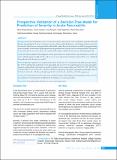Please use this identifier to cite or link to this item:
https://hdl.handle.net/20.500.14356/1595Full metadata record
| DC Field | Value | Language |
|---|---|---|
| dc.contributor.author | Bohara, Tanka Prasad | - |
| dc.contributor.author | Laudari, Uttam | - |
| dc.contributor.author | Parajuli, Anuj | - |
| dc.contributor.author | Rupakheti, Shail | - |
| dc.contributor.author | Joshi, Mukund Raj | - |
| dc.date.accessioned | 2023-05-16T07:35:17Z | - |
| dc.date.available | 2023-05-16T07:35:17Z | - |
| dc.date.issued | 2018 | - |
| dc.identifier.citation | BoharaT. P., LaudariU., ParajuliA., RupakhetiS., & JoshiM. R. (2018). Prospective Validation of a Decision Tree Model for Prediction of Severity in Acute Pancreatitis. Journal of Nepal Health Research Council, 16(2), 239-244. https://doi.org/10.33314/jnhrc.v16i2.1061 | en_US |
| dc.identifier.issn | Print ISSN: 1727-5482; Online ISSN: 1999-6217 | - |
| dc.identifier.uri | http://103.69.126.140:8080/handle/20.500.14356/1595 | - |
| dc.description | Original Article | en_US |
| dc.description.abstract | Abstract Background: Early identification of severe acute pancreatitis is important for early stratification, goal directed fluid therapy, rationalizing level of care to improve outcome. Various clinical, laboratory and imaging scoring system has been used to identify severe acute pancreatitis with variable results. Recently a decision tree model was proposed using serum creatinine, serum lactate dehydrogenase and oxygenation index to predict severe acute pancreatitis. This system is easy and usable at our centre. Hence, we conducted the study to validate the decision tree model prospectively. Methods: Patients admitted with a diagnosis of acute pancreatitis were included in the study. Decision tree model was used to identify patients at high and low risk for severe acute pancreatitis. Sensitivity and specificity were calculated for prediction of the decision tree model. Results: Fifty-three patients were included in the study. Fourty-one (77.4 %) patients with mild acute pancreatitis, five (9.4 %) patients had moderately severe pancreatitis and seven (13.2 %) patients had severe acute pancreatitis. Sensitivity and specificity of decision tree model to predict severity of pancreatitis was 97.83%(95 % CI – 88.47% to 99.94%) and 71.43 % % (95 % CI – 29.04% to 96.33%) respectively with positive and negative predictable value of 95.74 % % (95 % CI – 87.45% to 98.64%) and 83.33 % % (95 % CI – 40.49% to 97.35%) respectively. Conclusions: Decision tree model with serum creatinine, lactate dehydrogenase, and oxygenation index is an easy and useful tool to predict patients at high risk of developing severe acute pancreatitis. Keywords: Acute pancreatitis; decision tree; severe acute pancreatitis. | en_US |
| dc.language.iso | en | en_US |
| dc.publisher | Nepal Health Research Council | en_US |
| dc.relation.ispartofseries | Apr-June, 2018;1061 | - |
| dc.subject | Acute pancreatitis | en_US |
| dc.subject | Decision tree | en_US |
| dc.subject | Severe acute pancreatitis | en_US |
| dc.title | Prospective Validation of a Decision Tree Model for Prediction of Severity in Acute Pancreatitis | en_US |
| dc.type | Journal Article | en_US |
| local.journal.category | Original Article | - |
| Appears in Collections: | Vol. 16 No. 2 Issue 39 Apr-Jun 2018 | |
Files in This Item:
| File | Description | Size | Format | |
|---|---|---|---|---|
| 1061-Manuscript-5344-1-10-20180704.pdf | Fulltext Download | 308.84 kB | Adobe PDF |  View/Open |
Items in DSpace are protected by copyright, with all rights reserved, unless otherwise indicated.
